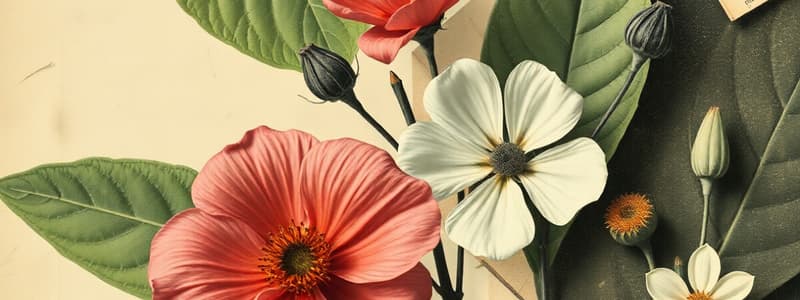Podcast
Questions and Answers
What is a characteristic of a simple leaf (JEDNODUCHÉ)?
What is a characteristic of a simple leaf (JEDNODUCHÉ)?
- Having a solid, undivided blade (correct)
- Consisting of multiple leaves
- Always needle-like
- Divided into several leaflets
What is a characteristic of compound leaves (ZLOŽENÉ)?
What is a characteristic of compound leaves (ZLOŽENÉ)?
- They are undivided.
- They are divided into multiple leaflets. (correct)
- They are always small.
- They are always flower-bearing.
Which type of leaf is typically thin, long, and adapted to coniferous trees?
Which type of leaf is typically thin, long, and adapted to coniferous trees?
- Compound (ZLOŽENÉ)
- Simple (JEDNODUCHÉ)
- Flowering (KVETNATÉ)
- Needle-like (IHLICOVITE) (correct)
What is the primary function of flowering leaves (KVETNATÉ)?
What is the primary function of flowering leaves (KVETNATÉ)?
What is the primary function of bracts (LISTENE)?
What is the primary function of bracts (LISTENE)?
What is the main function of assimilating leaves (ASIMILAČNE)?
What is the main function of assimilating leaves (ASIMILAČNE)?
What is the main function of cotyledons (KLIČNE)?
What is the main function of cotyledons (KLIČNE)?
Why do tree leaves fall in autumn?
Why do tree leaves fall in autumn?
What is the reason leaves change color in autumn?
What is the reason leaves change color in autumn?
What is the function of a flower (KVET)?
What is the function of a flower (KVET)?
Which of the following are the floral envelopes (Kvetné obaly)?
Which of the following are the floral envelopes (Kvetné obaly)?
Which parts consist of the pistil (Piestik)?
Which parts consist of the pistil (Piestik)?
What is a multiple fruit (Sükuetie)?
What is a multiple fruit (Sükuetie)?
What is pollination (Opelenie)?
What is pollination (Opelenie)?
What is self-pollination (SAMOOPELENIE)?
What is self-pollination (SAMOOPELENIE)?
What happens after pollination?
What happens after pollination?
What is an example of wind pollination (VETROM)?
What is an example of wind pollination (VETROM)?
What is insect pollination (HMYZOM)?
What is insect pollination (HMYZOM)?
What is a bisexual flower (AlDcOJ POHLAVNÉ)?
What is a bisexual flower (AlDcOJ POHLAVNÉ)?
What are fleshy fruits (DUŽINATE)?
What are fleshy fruits (DUŽINATE)?
Flashcards
Simple Leaves
Simple Leaves
Leaves with a single, undivided blade.
Compound Leaves
Compound Leaves
Leaves divided into multiple leaflets.
Bracts
Bracts
Modified leaves located beneath the flower.
Needle-Shaped Leaves
Needle-Shaped Leaves
Signup and view all the flashcards
Assimilation function
Assimilation function
Signup and view all the flashcards
Seed Leaves
Seed Leaves
Signup and view all the flashcards
Flower
Flower
Signup and view all the flashcards
Homochlamydeous flower
Homochlamydeous flower
Signup and view all the flashcards
Heterochlamydeous flower
Heterochlamydeous flower
Signup and view all the flashcards
Stamen
Stamen
Signup and view all the flashcards
Pistil
Pistil
Signup and view all the flashcards
Inflorescence
Inflorescence
Signup and view all the flashcards
Pollination
Pollination
Signup and view all the flashcards
self-pollination
self-pollination
Signup and view all the flashcards
Cross-Pollination
Cross-Pollination
Signup and view all the flashcards
Anemophily
Anemophily
Signup and view all the flashcards
Entomophily
Entomophily
Signup and view all the flashcards
Imperfect flower
Imperfect flower
Signup and view all the flashcards
Fruit
Fruit
Signup and view all the flashcards
Fleshy fruits
Fleshy fruits
Signup and view all the flashcards
Study Notes
- ZHRNUTIE
List
- Types of leaves are simple, compound, and needle-like
- Simple leaves can be whole or deeply lobed
- Compound leaves are divided into multiple leaflets
- Needle-like leaves are narrow and pointed
Leaf Arrangement
- Leaf arrangement includes flowering, leafy, assimilating, and cotyledonous leaves
- Flowering leaves are variously colored and part of the flower
- Leafy leaves are located under the flower and serve for protection
- Assimilating leaves are necessary for photosynthesis
- Cotyledonous leaves emerge with the root and are the first
Why Leaves Fall Off
- Trees shed leaves in autumn to get rid of harmful substances
Why Leaves Change Color
- Leaves change color in the fall because there are fewer photosynthetic pigments and less chlorophyll, thus other colors become more pronounced.
Flower
- Flowers serve for reproduction, are plant reproductive organs, and ensure seed formation for the next generation.
- Floral envelopes are either uniform or diverse.
Flower Parts
- Stamen includes anthers, pollen grains, and filaments
- Pistil includes stigma, style, ovary, ovules, and seeds
- Aggregate flowers have multiple separate flowers, and individual flowers grow separately
Pollination
- Pollination occurs when pollen grains are transferred to the pistil's stigma.
- Pollination is either self-pollination or cross-pollination
- After pollination, fertilization happens when the male germ cell merges with the female one, and seeds start to form from the ovules.
Pollen Transfer
- Pollen transfer occurs by wind (anemophily) or insects (entomophily)
- Seed plant flowers can be bisexual or unisexual
Fruit
- The fruit forms after pollination and fertilization through the transformation of a pistil or seed.
- Fruits are divided into fleshy fruits and dry fruits.
- Fleshy fruits contain water when ripe (e.g., drupes, berries, stone fruits)
- Dry fruits loose water when ripe, can be dehiscent or indehiscent
Studying That Suits You
Use AI to generate personalized quizzes and flashcards to suit your learning preferences.




